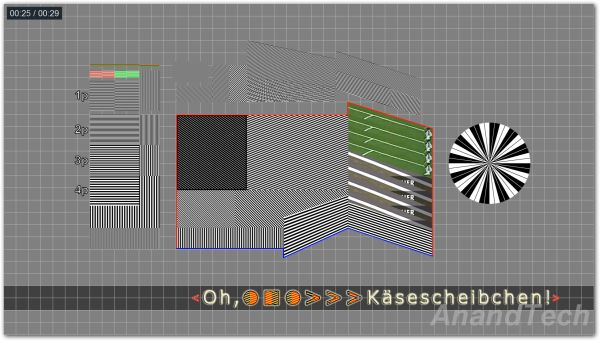Discrete HTPC GPU Shootout
by Ganesh T S on June 12, 2011 10:30 PM EST
Mismatches in the display refresh rate and source frame rate are difficult to spot for the average HTPC user, particularly if the dropped or repeated frames are far apart. Bad deinterlacing performance, on the other hand, may easily ruin the HTPC experience even for the average user. From DVDs to recorded TV shows and even Blu-ray documentaries, interlaced content is quite common.
We have been using the Cheese Slices test to check up on deinterlacing performance in the past. Instead of just covering the cheese slice alone, we will present a set of four consecutive deinterlaced frames from the video for you to judge.
Before presenting the results, let us take a look at how the ideal deinterlacing output should look like (a screenshot from the progressive version of the Cheese Slices clip around the same timestamp)
Click for Lossless Version
NVIDIA GT 430 Cheese Slices Deinterlacing:
MSI GT 520 Cheese Slices Deinterlacing:
AMD 6450 Cheese Slices Deinterlacing:
MSI 6450 Cheese Slices Deinterlacing:
Sapphire 6570 Cheese Slices Deinterlacing:
The Cheese Slices test is an artificial test clip. To bring some real world perspective to the deinterlacing performance, let us take a look at some screenshots of the 'Ship' clip from the Spears and Munsil High Definition Benchmark Test Disc (hereon referred to as the S&M clip). It is supposed to test the edge adaptive deinterlacing capabilities of the GPU. Note the jaggies in the various ropes in the screenshot. Roll the mouse over the various GPUs in the list below the image to see how each candidate performs.

| MSI GT 520 | MSI 6450 | NVIDIA GT 430 | Sapphire 6570 |
Pay particular attention to the deinterlacing performance of the GT 520. Compared to the other 4 cards in the test, this one emerges as the worst of the lot in the Cheese Slices test as well as the real world video test. When this was brought to NVIDIA's attention, they indicated the lack of shaders on the GF119 as the main reason for this issue. It looks like driver updates are not going to solve the issue in the future either. This is a big letdown for the prospective customers of the GT 520. Even though the deinterlacing performance of the GT 430 looks pretty good, a closer look reveals that it is not as effective as AMD's vector adaptive deinterlacing strategy.
On the AMD side, it looks like the reduced core clock frequency and lessened DRAM bandwidth of the MSI 6450 doesn't affect the deinterlacing performance in the Cheese Slices test. Vector adaptive deinterlacing works across all the cards in the 6xxx lineup. However, AMD has admitted to some driver issues for local file playback in the DDR3 based 6450s. This is probably the reason for the bad performance of the MSI 6450 in the S&M ship clip above. In an informal blind test, a majority seemed to prefer the 6570's output in the clip above, but you can decide for yourself.
The Catalyst Control Center allows users to experiment with different deinterlacing algorithms, while NVIDIA's Control Center doesn't. Admittedly, this choice of deinterlacing algorithms is of academic interest only. That said, the bad deinterlacing performance of the GT 520 and the fact that it is not going to improve in the future forces us to declare AMD the winner in this area.































70 Comments
View All Comments
ganeshts - Thursday, June 16, 2011 - link
PotPlayer apparently doesn't have support for hardware deinterlacing, and has a host of other issues [ Search for PotPlayer in this page and then read the next set of posts about it : http://www.avsforum.com/avs-vb/showthread.php?p=20... ].Of course, if it works for you, it is great :) (probably it is a good solution for people watching progressive material only).
The author of LAV CUVID talks in that thread about how renderless DXVA mode works with madVR at the cost of deinterlacing.
Btw, there is no decode of DTS-HD in any open source software now. Both ffdshow and PotPlayer can decode only the core DTS soundtrack. DTS decode has been around for a long time, though.
NikosD - Saturday, June 18, 2011 - link
Indeed, I was referring to progressive material only - interlaced material is rare - but the page you mentioned says PotPlayer has CPU deinterlacing.I don't see where is the problem.
Hardware Deinterlacing is less important - for most users - than Hardware Decoding (DXVA) and less important than the UNIQUE capability of using DXVA + madVR at the same time.
The cost of hardware deinterlacing is nothing compared to the cost of DXVA and madVR.
For the audio part of your answer, I have to say that because of my AVR (Pioneer VSX-920) decoding inside a PC, BluRay, Media Player or any other decoding capable device of multi-channel audio is never an option for me.
I always prefer the bitstreaming solutions for multi-channel audio - as most of the owners of AVR do - like those provided by FFDshow and PotPlayer which both are more than capable of providing them.
That's why I wrote "decoding and pass-through", I had to write "splitting and pass-through".
One last word.
For every piece of software out there, there is always a list of changes, bugs, things to do.
That doesn't mean we don't use it or like it.
PR3ACH3R - Friday, June 17, 2011 - link
@Ganesh T S,This is some NICE work.
In fact, I cannot recall when was the last time I have seen such an in depth article on the HTPC GPU subject in Anandtech.
The balance between the technical issues, the background, & the effort to honestly report all issues known to you in this article, is spot on.
If it is missing something on the issues report, it misses on the ATI/AMD DPC Latency spiking issues.
As this is still remains unnoticed in Anandtech even in this excellent article, here is a link to the AVS post describing it.
http://www.avsforum.com/avs-vb/showthread.php?t=12...
(Ignore some of the discredit attempt posts in this thread, this problem exists to this very day.)
NikosD - Thursday, June 23, 2011 - link
Well, I did some further tests and found out that PotPlayer does have hardware deinterlacing.Have you done any tests by yourself to see if the player supports Hardware Deinterlacing ?
ganeshts - Saturday, June 25, 2011 - link
NikosD, I will definitely try PotPlayer out in the next GPU review. Till now, my knowledge is limited to what is there in the AVSForum thread.flashbacck - Friday, June 24, 2011 - link
I know HTPCs are even more of niche these days than ever, so I appreciate you still doing these tests very much.wpoulson - Thursday, July 28, 2011 - link
I really appreciate this guide and have been stepping through itI just registered the ASVid.ax file from TMT5 but the filter is not showing up in the External Filter section of MPC-HC. At first I thought it might be because I registered it on the 32 bit side and I'm using 64 bit MPC-HC, so I unregistered the file from System 32 and registered it on the 64 bit side.
I registered it by going to Start>CMD>Cntrl-Shift-Enter and using the "Regsvr32" command to register the file. I put the file along with the checkactivate dll in a folder in the root directory of my C drive and pointed the Regsvr command to the ASVid.ax file. After hitting enter, I received a "dll successfully registered" message.
Can someone help me to get the filter visible for MPC-HC?
A question...While it's considered beta, will the new LAV video decoder do the same thing the arcsoft video decoder does?
Thanks
Warren
stuartm - Friday, January 20, 2012 - link
I am aware the gt 430 is a good choice to work around the infamous WMC 29/59 framerate bug. Can you comment on whether or not the 6570 will stutter or not when playing content with 29/59 framerate problems? A very important consideration for those of us using ceton or HDHR Primes (or the new Hauppauge box) for cable TV Live viewing and record/replay.Thank You
MichaelSan1980 - Saturday, January 21, 2012 - link
I'd use my HTPC for DVD's and BD's only with an Full-HD TV. Since i have a rather strong CPU and wouldn't use Hardware Deinterlacing for DVDs, i wonder, if the GT520 is ~that~ bad, in terms of image quality?drizzo4shizzo - Wednesday, June 20, 2012 - link
Old guy here.In the market but I need confirmation that these cards can do component output to "old guy" HDTV.
NONE of the marketing materials suggest that any recent card can.
Meaning they either come with a component video breakout or at least are compatible with a known 3rd party product, and that they can do the RGB -> YUV thing.
This ancient EVGA 7600 GT I have does it... with an "svideo lookalike" 7 pin -> component breakout.
Anyone? Beuller?